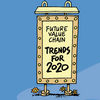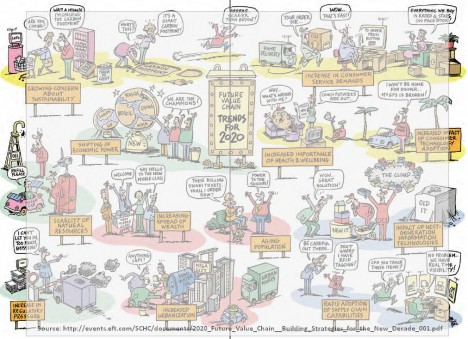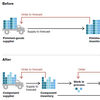 The twelve future trends that will shape value chains and supply chain management during this decade. Are you ready for what is coming? If you need an inspiring break in your daily routine, this is the report for you, and I haven’t had this much fun when reading a report for a long time. Although printed on glossy paper and richly illustrated, most company reports or whitepapers are usually not an overly exciting read. This one is. Whoever decided the layout and graphics for this report must have had a great time doing so. There simply is no better way to get the message across and to show the 12 global root trends that address change in society, shopper behavior, environment and technology. Above all, sustainability is the new buzzword. And lest not forget, supply chain risk and business continuity are part of the picture…implicitly.
The twelve future trends that will shape value chains and supply chain management during this decade. Are you ready for what is coming? If you need an inspiring break in your daily routine, this is the report for you, and I haven’t had this much fun when reading a report for a long time. Although printed on glossy paper and richly illustrated, most company reports or whitepapers are usually not an overly exciting read. This one is. Whoever decided the layout and graphics for this report must have had a great time doing so. There simply is no better way to get the message across and to show the 12 global root trends that address change in society, shopper behavior, environment and technology. Above all, sustainability is the new buzzword. And lest not forget, supply chain risk and business continuity are part of the picture…implicitly.
Where are we going?
In 2009 I posted about the then current logistics and supply chain management trends, a post that grew to become one of my most popular posts. Obviously it is important to stay ahead of what is happening and where the future is going. The report in today’s post is fascinating to say the least and here are the 12 trends:
Increased urbanization
Among the consequences of urbanization for the consumer goods and retail industry will be a shift to smaller-footprint stores, with no room for unproductive inventory.
Aging population
Retailers will need to consider changes to their business model to accommodate the needs of an older population. this might include shuttle services, more home delivery, wider aisles, stores in nursing homes and assisted-living facilities, largeprint labels, among other developments.
Increasing spread of wealth
the rise in the developing world’s middle class will lead to an increase in consumption, which may have implications for availability and price of commodities like oil and foodstuffs.
Technology adaptation and the rise of social media
The wider use of new technology and new tools will impact not only consumers’ own behavior but will also influence the buying behavior of other consumers as the use of social media continues to spread. Keys to success will be selecting the right social communities to effectively interact with the target consumer groups, and determining how to leverage the huge amounts of online consumer data.
Consumer service demands
The exponential growth and adoption of consumer technologies will drive new levels of service demands by shoppers and consumers. We will see the rise of a stronger web-based service economy, giving consumers greater choice of shopping options and improved transparency. In this environment, consumers will expect and demand services 24/7.
Importance of health and wellbeing
Health, safety and wellbeing are increasingly important to consumers as well as to manufacturers and retailers, and will have significant ramifications in the future as shoppers place greater attention on more healthful products as well as healthier lifestyles.
Growing consumer concerns about sustainability
Consumer awareness and carbon-footprint regulations are expected to significantly increase, as consumers look to governments and companies to play a major role in combating climate change.
 Shifting of economic power
Shifting of economic power
In the next decade new economic powers like China and India will continue to rise. As this power shift occurs, a volatile global economy will remain the norm for the coming decade. trade areas will evolve and a new generation of globally competitive companies from developing markets will emerge, helping to further solidify their position in the global marketplace.
Scarcity of natural resources
By 2030, the world’s population will reach 8.3 billion, with the demand for food and energy increasing by 50% and for fresh water by 30%. This growth will continue to put pressure on natural resources like energy, water and food, with demand projected to outstrip easily available supplies over the next decade, resulting in increasing production costs.
Energy: As the cost of fossil fuel remains volatile and supplies finite, an energy revolution could occur in the coming decade with wind and solar becoming viable sources of energy in some parts of the world.
Water: Water-related disruptions in the agricultural supply chain will have a dramatic impact on the industry’s economic performance. Additional challenges may come in the form of plant siting obstacles in waterstressed countries and stricter water policies.
Food: Global economic growth and climate change impact on the availability of food ingredients will lead to volatile food prices over the next decade.
Increase in regulatory pressure
Over the next decade regulatory pressure is expected to increase, particularly for hot-button areas like the environment and sustainability. Food safety is likely to be the key focus for regulatory action.
Rapid adoption of supply chain technology capabilities
In the coming decade, improved collaboration together with new supply chain/logistics technologies and information transparency will enable a more synchronized value chain with greater visibility and traceability.
Impact of Next-Generation Information Technologies
Information technology will no longer be just an indispensable support function, but an expansion of the organization’s intelligence, a universal connector, the way to become adaptive. new waves of business technology solutions will enable manufacturers and retailers to quickly and dynamically simulate, describe, model, execute and manage business processes.
Risks, disruptions, contingencies and continuity
As said above, supply chain risk and business continuity are only implicitly mentioned in these future trends. For the record, in the 62-page report, the word disruption only occurs three times, business continuity occurs once, risk is found twice, and contingency plan once. However, sustainable/sustainability occurs no less than 91 times and clearly, that is the real future trend and was already identified as an emerging research area in Stonebraker et al. (2009).
Being serious while having fun
What I like most about this report are the comicky to-the-point illustrations which make the report so easy to read (you can just look at the pictures, if you want). It brings the point across, and I can imagine that this report is one of the easiest to present to absolutely any audience. I simply love it.
Download
- eft.com: Future Value Chain Trends 2020
Related link
Related posts
- husdal.com: Logistics and supply chain trends 2009
- husdal.com: Sustainable supply chains












